------------------------------------------------------------------------------------------------------------------------------------------------------------------------------------------TURKISH ODYSSEY
October 3-15, 2019
----------------------------------------------------------- ----------------------------------------------------------------------------------------------------------------------------
October 3-4, 2019
2019 TURKEY ODYSSEY BY GATE 1
FLAG OF TURKEY
October 3-4
JFK*ISTANBUL
Traveling to Istanbul, Turkey from John F. Kennedy International Airport. Arrived in Istanbul at the new and very modern airport, Istanbul Havalimani, got picked up by the Discovery representatives then checked in at 10 Karakoy Hotel. JJ was already there so we went out to lunch after I took a quick nap and shower.
 |
 |
 |
 |
 |
 |
 |
 |
October 5
ISTANBUL CITY TOUR: BLUE MOSQUE*HAGIA SOPHIA*TOPKAPI*BAZAAR
Busy day today, lots of walking...Blue Mosque, Hagia Sophia, Topkapi Museum, Bazaar. I’ve been to all of them except Topkapi.
BLUE MOSQUE (Sultan Ahmed Mosque) is a historic functioning mosque, and was constructed between 1609 and 1616. Its Külliye contains Ahmed's tomb, a madrasah and a hospice. Hand-painted blue tiles adorn the mosque’s interior walls, and at night the mosque is bathed in blue as lights frame the mosque’s five main domes, six minarets and eight secondary domes. It is a UNESCO World Heritage Site. On the way to the Blue Mosque we passed through the Hippodrome where Constantine and Theodosius the Great, brought works of art (Serpent Column, moved from the Temple of Apollo at Delphi and an obelisk from the Temple of Karnak in Luxor during the reign of Thutmose III in about 1490 BC; the Kaiser Wilhelm Fountain, which was constructed by the German government in 1900 to mark the Emperor's visit to Istanbul in 1898.
 |
 |
 |
 |
 |
 |
 |
HAGIA SOPHIA is the former Greek Orthodox Christian patriarchal cathedral, later an Ottoman imperial mosque and now a museum (Ayasofya Müzesi) in Istanbul. Built in AD 360, it was famous in particular for its massive dome. It is considered the epitome of Byzantine architecture. It is a UNESCO World Heritage Site.
 |
 |
 |
 |
 |
 |
 |
 |
 |
 |
 |
 |
 |
 |
 |
 |
TOPKAPI, originally called the "New Palace" was built in 1459 by Mehmed the Conqueror as the main residence and administrative headquarters of the Ottoman sultans. In 1923, Topkapı was transformed into a museum by a government decree. The Topkapı Palace Museum includes the Ottoman Imperial Harem and the Treasury, where the Spoonmaker's Diamond and Topkapi Dagger are on display.
 |
 |
 |
 |
 |
 |
 |
Lunch, consisting of several fish dishes, was at a Cretan restaurant.
 |
 |
 |
GRAND BAZAAR, is one of the largest and oldest covered markets in the world, with 61 covered streets and over 4,000 shops and was listed as No.1 among the world's most-visited tourist attractions with 91,250,000 annual visitors.
 |
 |
 |
 |
 |
 |
 |
October 6
FATIH*BALAT*TAKSIM SQUARE-ISTIKLAL*BIBERON
Today we went first to Fatih where we walked around the neighborhood. Stopped at the Orthodox Church Vlaherna Meryem Ana.
 |
 |
 |
 |
 |
 |
 |
BALAT Then passed the colorful neighborhood of Balat, a UNESCO World Heritage Site. Balat is a down-to-earth neighborhood of narrow cobbled streets and colorful houses, where hip cafes and cutting-edge galleries sit next to old-school neighborhood grocers.
 |
 |
 |
 |
 |
 |
 |
 |
 |
 |
CHURCH OF ST GEORGE Next we visited the Church of St. George, the principal Eastern Orthodox cathedral still in use in Istanbul.
 |
 |
 |
CHURCH OF ST STEPHEN Also visited the Bulgarian St Stephen Church, also known as the Bulgarian Iron Church, famous for being made of prefabricated cast iron elements in the neo-Gothic style.
 |
 |
 |
TAKSIM SQUARE*ISTIKLAL We went next to Taksim Square in Beyoğlu where the new mosque Taksim Masjid dominates the area. Had a Kizilkayalar hamburger for lunch then walked to Istiklal, a busy shopping street, where we had pistachio ice cream at Mado. We passed by a bazaar with green grocers and seafood restaurants.
 |
 |
 |
 |
 |
 |
 |
 |
 |
 |
CHURCH OF ST ANTHONY*BIBERON CAFE We visited St. Anthony of Padua Church, or locally as Sent Antuan, a basilica and the largest church of the Roman Catholic Church in Istanbul. And then a cup of Turkish coffee and a piece of cake at Biberon before we went back to the hotel. We later took the funicular back to Istiklal for dinner.
 |
 |
 |
 |
 |
 |
 |
 |
 |
 |
October 7
DALAMAN*DALYAN*FETIYE
Flew to Dalaman then tour bus to Dalyan where we had lunch at the Casa Nova. Above the river's sheer cliffs are the weathered façades of Lycian tombs cut from rock, circa 400 BC. The ruins of the ancient trading city of Kaunos are a short boat trip across the river.
 |
 |
 |
 |
 |
 |
 |
 |
 |
 |
 |
 |
 |
 |
 |
FETIYE Next we drove to Fethiye, a port city, and district, on Turkey's southwestern Turquoise Coast. It's known for its natural harbor, blue waters and numerous rock tombs including the 4th-century B.C. Tomb of Amyntas, carved into a bluff overlooking the city. Checked in at the beautifully appointed Hotel Ecesaray in the waterfront. Later we had a nice dinner of lamb dish garnished with peppers, onions and tomatoes with brown sauce. Refreshing salad and ravioli were also served together with a nice glass of red wine (Kizilbet).
 |
 |
 |
 |
 |
 |
October 8
AEGEAN BOAT TRIP*GOBUN RESTORAN*FETIYE
After a nice breakfast at the rooftop terrace of the hotel we went on a boat trip on the Aegean. Unfortunately it was cloudy and drizzly and the ride was not smooth. We finally got to the island and had a nice lunch at Göbün Restoran. Due to the rough seas I had a couple of rakis! After lunch we swam a little because the seas finally calmed down. Got back to town and watched the loggerhead turtles swimming by the boats along the pier. Dinner was at the waterside outdoor restaurant of the hotel.
 |
 |
 |
 |
 |
 |
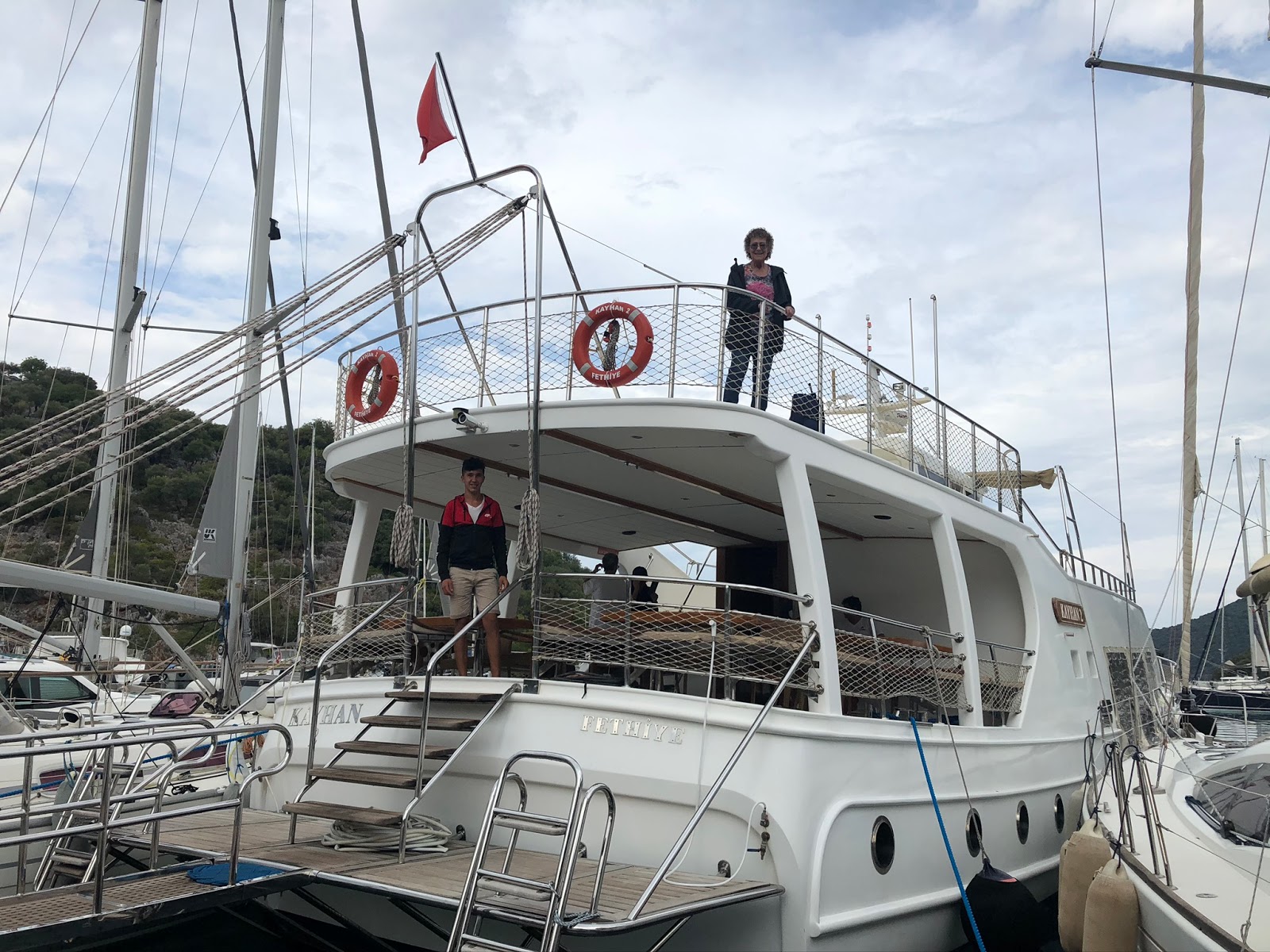 |
 |
 |
 |
 |
 |
October 9
SAGALASSOS
Today we drove quite a ways and stopped at a restaurant inside a park where we saw a newlywed couple being photographed in the gardens before we drove on to the Roman ruins in Sagalassos, one of the best-preserved ancient cities in ancient Pisidia in the province of Burdur. It was conquered by Alexander the Great in 333 BC on his way to Persia. It flourished after joining the Roman Empire in 25 BC. The archeological record indicates that locals rapidly adopted Hellenic culture. The city has been excavated since 1990 by archaeologists from the University of Leuven in Belgium. The site features a huge Roman bath complex, library, urban mansion with more than 80 rooms, and theatre with seating for up to 9000 people, as well as other monuments from the city’s 1000 year history. Excavated finds have been exhibited at the Burdur Museum. We stayed at the Sagalassos Lodge and Spa.
 |
 |
 |
 |
 |
 |
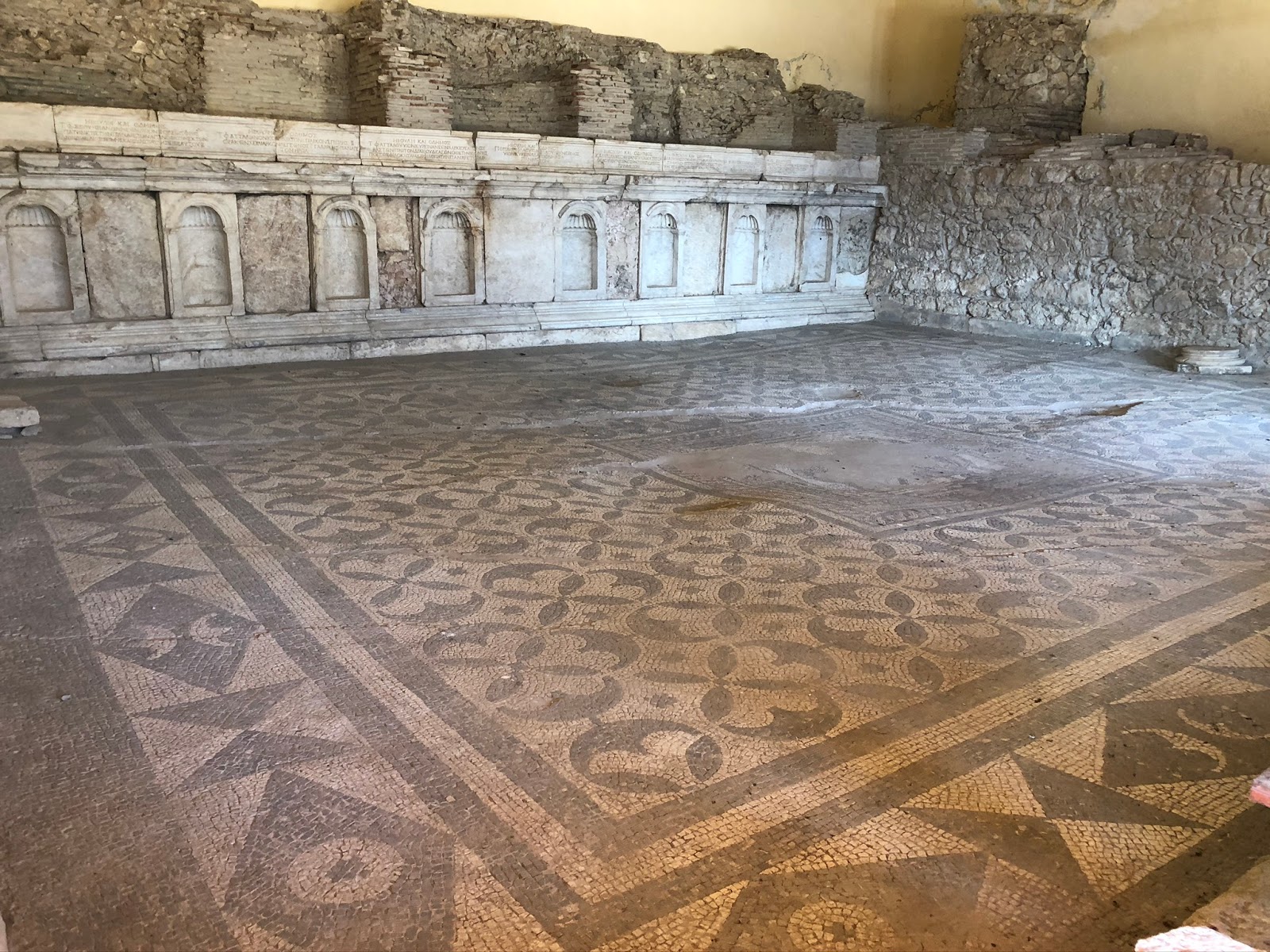 |
 |
 |
 |
 |
 |
 |
 |
 |
 |
 |
 |
October 10
KONYA*SULTANHAN CARAVANSERAI*CAPPADOCCIA
We drove to Konya and visited the Museum of Mevlana, the mausoleum of Jalal ad-Din Muhammad Rumi, a Persian Sufi mystic also known as Mevlana.
 |
 |
 |
 |
 |
 |
 |
MUSEUM OF MEVLANA Our next stop is the Museum of Mevlana, the mausoleum of Jalal ad-Din Muhammad Rumi, a Persian Sufi mystic also known as Mevlâna or Rumi. It was also the dervish lodge (tekke) of the Mevlevi order, better known as the whirling dervishes.
 |
 |
 |
 |
 |
 |
 |
 |
 |
 |
 |
 |
 |
 |
 |
 |
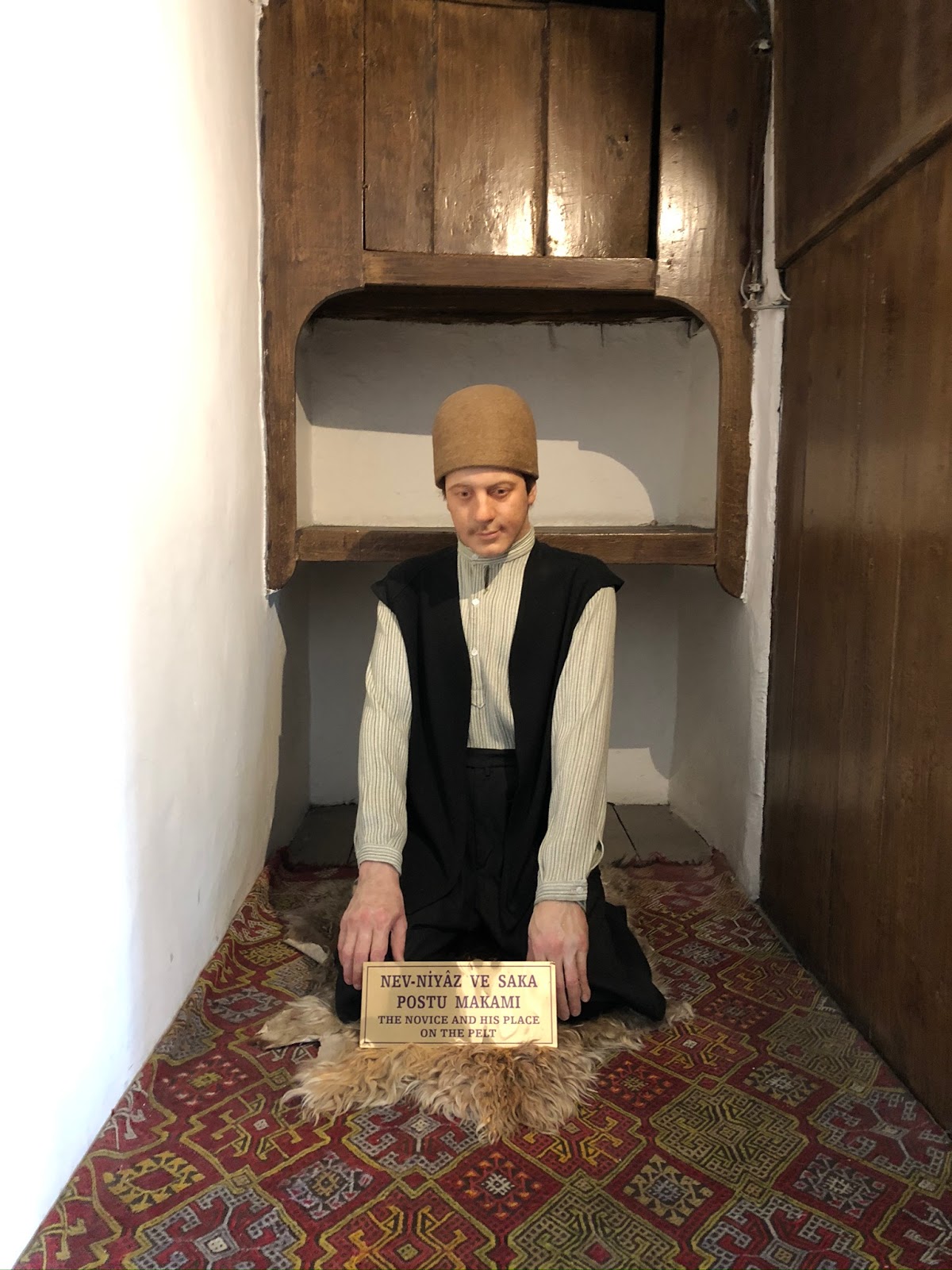 |
 |
 |
 |
CARAVANSERAI SULTANHAN*DINNER AT LOCAL FAMILY HOME We also stopped at a the Sultanhan caravansarai before we drove to our visit and dinner at a local family’s home. Great food!
 |
 |
 |
 |
 |
 |
YUNAK EVLERI HOTEL Checked in at Yunak Evleri, set in Cappadocia’s landscape of fairy chimneys, a unique cave hotel carved into a mountain cliff which offers rooms dating back to the 5th century.
 |
 |
 |
October 11
CAPPADOCCIA*BALLOON RIDE
Woke up early for this morning's balloon ride! Exhilirating! Champagne and strawberries with chocolate...perfect!
 |
 |
 |
 |
 |
 |
 |
 |
 |
 |
 |
 |
 |
 |
 |
 |
GOREME OPEN AIR MUSEUM After breakfast at the hotel, we went to the Goreme Open Air Museum, a UNESCO World Heritage Site, and saw several churches with original paintings by early Christians.
 |
 |
 |
 |
 |
 |
 |
 |
 |
 |
KAYMAKLI UNDERGROUND CITY Stopped at another photo op then a great lunch at a small restaurant before we went to the Kaymakli Underground City, a UNESCO Heritage Site. The Kaymakli caves may have first been built in the soft volcanic rock by the Phrygians, an Indo-European people, in the 8th–7th centuries B.C. When the Phrygian language died out in Roman times, replaced with Greek, the inhabitants, now Christians, expanded their caverns adding the chapels and inscriptions. The city was greatly expanded and deepened in the Byzantine era, when it was used for protection from Muslim Arab raids during the four centuries of Arab–Byzantine wars (780-1180). These cities continued to be used by the Christian inhabitants as protection from the Mongolian incursions of Timur in the 14th century. After the region fell to the Ottomans, the cities were used as refuges from the Turkish Muslim rulers, and as late as the 20th century the inhabitants, called Cappadocian Greeks, were still using the underground cities to escape periodic waves of Ottoman persecution.
 |
 |
 |
 |
 |
 |
 |
 |
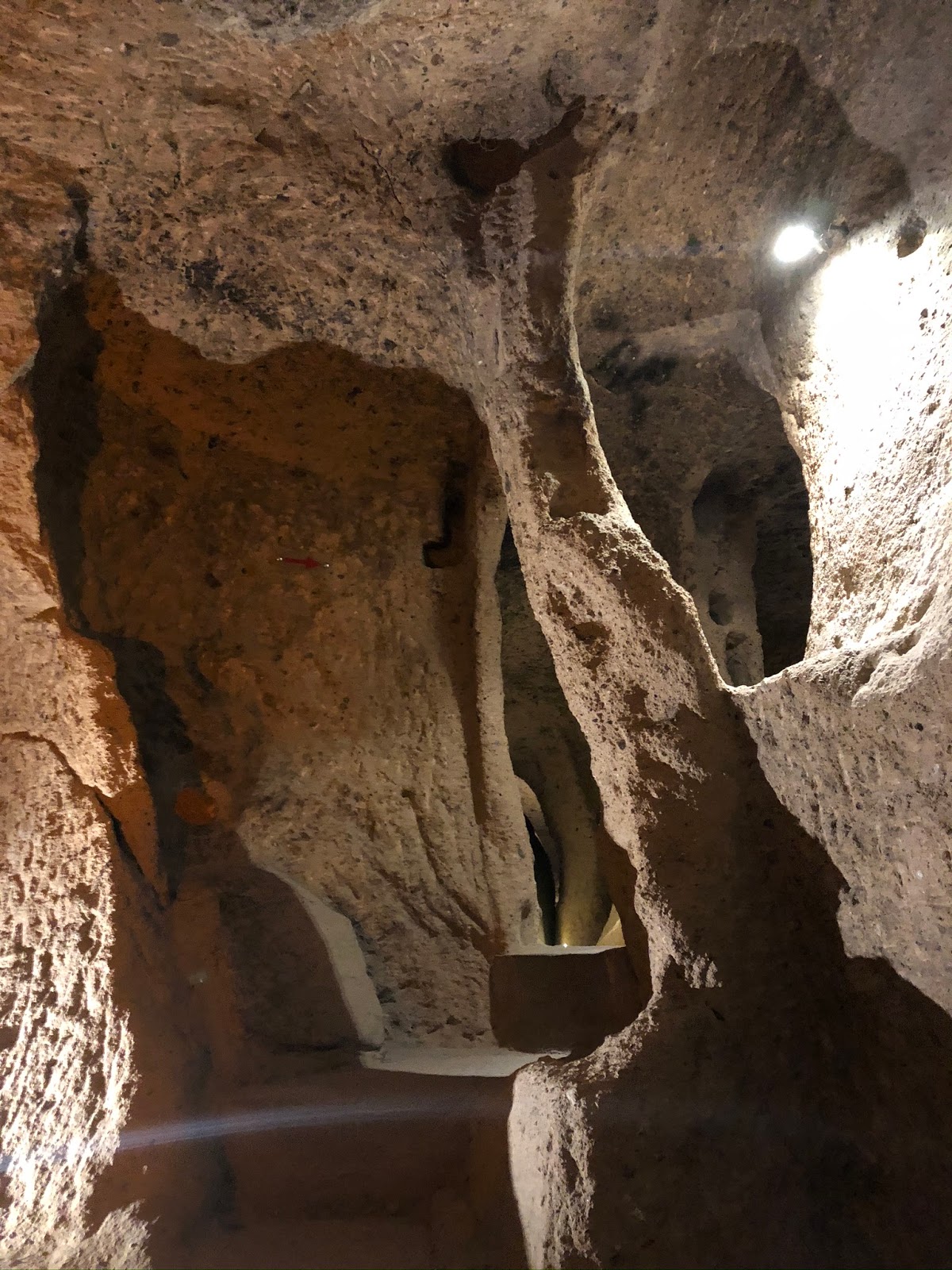 |
 |
 |
 |
 |
 |
CAVE HOME VISIT We next visited the private cave home of Adnan, a friend of our tour manager Namik Istkoy.
 |
 |
 |
 |
 |
 |
 |
 |
 |
 |
SARUHAN WHIRLING DERVISHES we stopped at Saruhan, a 13th century Seljuk Caravanserai where we watched the Whirling Dervishes.
 |
 |
 |
 |
 |
 |
 |
October 12
ON THE ROAD TO SAFRANBOLU
Leaving Cappadoccia this morning, took more pics of our cave hotel, Yunak Evleri, and first stop was the art and rug company called Doku-Art, where I bought a runner.
 |
 |
 |
 |
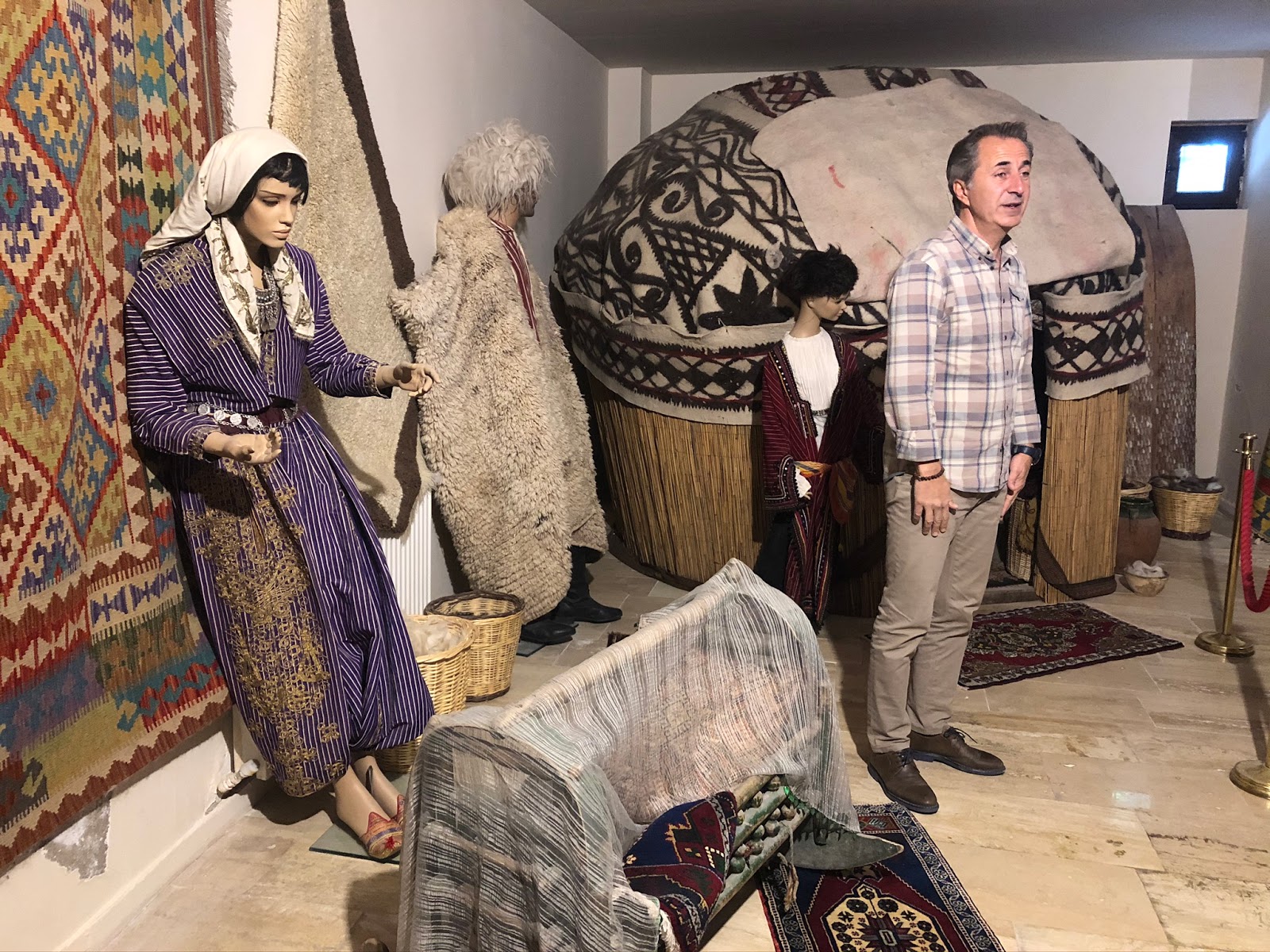 |
 |
 |
 |
 |
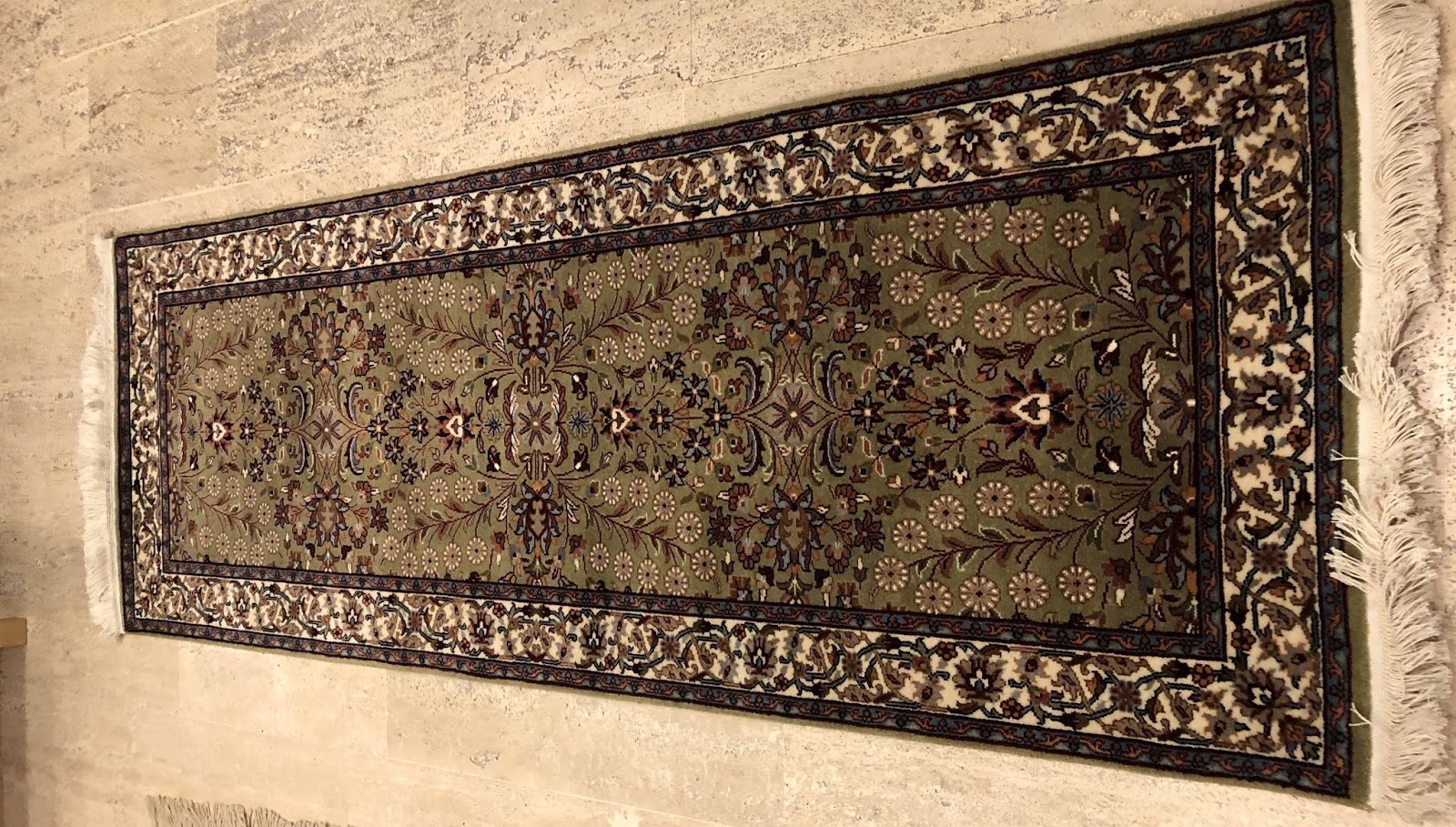 |
October 13
SAFRANBOLU*KRISTAL TERAS*YÖRÜK KÖYÜ
Safranbolu is a town and district of Karabük Province in the Black Sea region of Turkey. The name of the town derives from "saffron" and the Greek word polis, since Safranbolu was a trading place and a center for growing saffron. Safranbolu was added to the list of UNESCO World Heritage sites in 1994 due to its well-preserved Ottoman era houses and architecture. First stop this morning was Kristal Teras where we walked on glass panels to see the canyon below. The upside down house was in the area too. Then we drove to the village of Yörük Köyü, a still inhabited village near Safronbolu settled centuries ago by the Dervish and subsequently thrived during the Ottoman Empire. Our visit included seeing the old laundry house where families gathered to wash clothing on huge circular stone platform. Next we visited a private home of one of the leaders of the village.
KRISTAL TERAS
 |
 |
 |
YÖRÜK KÖYÜ In the written legends about Yörük Village, the nomads in the 14th and 15th centuries settled here where they built mansions similar to the ones they saw along the Bosphorus. The village laundry, which is estimated to date back to 300-350 years, is used as an art gallery today. The center of the laundry was designed at different heights considering women of different sizes. There was a bust of the late Leyla Gencer, a world- famous opera singer, in the village.
 |
 |
 |
 |
 |
 |
 |
 |
 |
 |
 |
 |
 |
 |
 |
 |
 |
 |
KADIOĞLU We had a good lunch, Saç Kavurma, at Kadıoğlu Şehzade Sofrası. After lunch we spent time shopping at the Bazaar.
 |
 |
 |
SAFRANBOLU BAZAAR After lunch we went shopping at the town's bazaar for some souvenirs. I bought a pair of slippers and an onyx ring.
 |
 |
 |
October 14
ISTANBUL
Drove back to Istanbul and arrived in the afternoon, checked in at 10 Karakoy Hotel. Went to lunch in the neighborhood then walked across the Galata bridge to the market.
 |
 |
 |
 |
 |
 |
 |
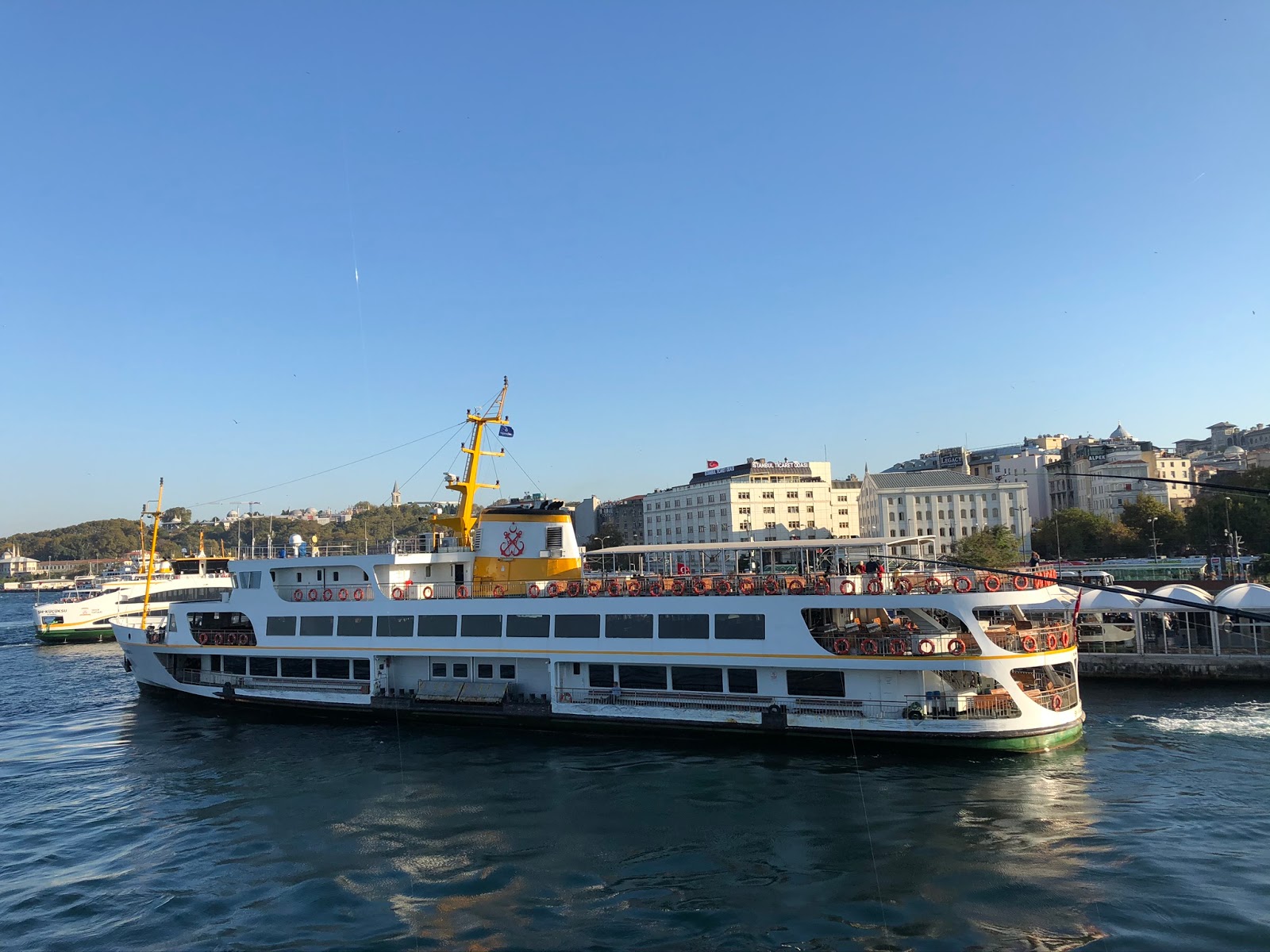 |
 |
 |
 |
 |
 |
 |
 |
 |
 |
FAREWELL DINNER AT FIRUJE Tonight is the farewell dinner at Firuje overlooking the Bosphorus and the city.
 |
 |
 |
 |
 |
 |
October 15
ISTANBUL*DOLMABAHÇE
We visited the famous Dolmabahçe Palace, the main administrative center of the Ottoman Empire from 1856 to 1887 and from 1909 to 1922. Dolmabahçe Palace was ordered by the Empire's 31st Sultan, Abdülmecid I, and built between the years 1843 and 1856. Previously, the Sultan and his family had lived at the Topkapı Palace. The construction cost five million Ottoman gold lira, or 35 tons of gold. The palace was home to six Sultans from 1856. The last royal to live here was Caliph Abdülmecid Efendi. A law that went into effect on March 3, 1924 transferred the ownership of the palace to the national heritage of the new Turkish Republic. Mustafa Kemal Atatürk, the founder and first President of the Republic of Turkey, used the palace as a presidential residence during the summers. Atatürk spent the last days of his medical treatment in this palace, where he died on November 10, 1938. Dolmabahçe has the largest collection of Bohemian and Baccarat crystal chandeliers in the world. The famous Crystal Staircase has the shape of a double horseshoe and is built of Baccarat crystal, brass and mahogany. The palace includes a large number of Hereke palace carpets made by the Hereke Imperial Factory. Photos of the interiors are from the internet since no photography is allowed inside the palace.
 |
 |
 |
 |
 |
 |
 |
 |
 |
 |
 |
 |
 |
 |
 |
 |
 |
 |
 |
 |
MISCELLANEOUS PHOTOS
 |
 |
 |
 |
 |
 |
 |
 |
 |
 |
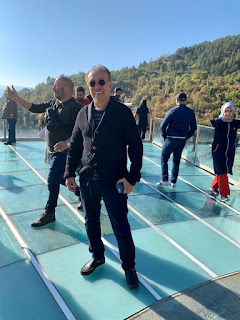 |
ISTANBUL*NEW YORK Flew back to New York in the afternoon. Wonderful vacation!











